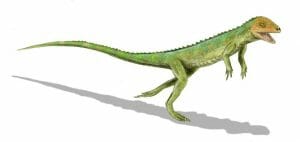The term bipedal comes from Latin and loosely translates to “two feet.” Bipedalism is a form of locomotion for organisms that live on land and can be in the form of running, walking and/or hopping. Bipedalism can also describe animals that stand on two feet but do not necessarily walk or run that way. Some animals walk on two feet all the time while other animals are quadrupeds and do it only intermittently. Bipedalism offers several advantages to species. For example, in humans, walking upright raises the head which gives a better view for seeing dangers and approaching predators.
Evolutionary theories about how and when animals became bipedal are abundant, with at least 12 ideas currently being studied. One theory explains that humans may have developed bipedalism in order to carry food to share with other group members.
Amphibians
There is no evidence that any amphibians, either modern day or in the fossil record, are or ever have been bipedal.
Reptiles
Lizards often adopt a bipedal stance for running away from predators. One example of this the spiny-tailed iguana which is known as the world’s fastest lizard. The fossil record shows that the first bipedal animal on Earth was a reptile known as Eudibamus which lived about 290 million years ago.

The image above shows the first known bipedal animal Eudibamus which lived about 290 million years ago.
Birds
All birds display bipedalism. This makes sense because of their evolutionary relationship to the dinosaurs who were mostly bipedal.
Mammals
Nearly all primates are capable of bipedalism, although most spend the majority of their time on all fours. Primates move bipedally but they also use bipedalism to stand up on their hind legs to reach food and look for predators. Some examples are baboons, bonobos, chimpanzees and gibbons. Other mammals such as beavers, raccoons, mice and rats squat on their back legs while eating, and raccoons and beavers walk bipedally when carrying things. Other bipedal mammals are rabbits, bears, meerkats and ground squirrels. Kangaroos and wallabies are examples of bipedal marsupials.
References
- Bipedalism. (n.d.). In Wikipedia. Retrieved July 19, 2017 from https://en.wikipedia.org/wiki/Bipedalism
